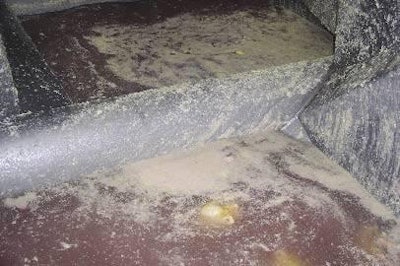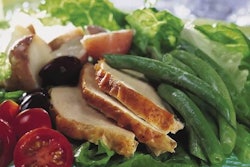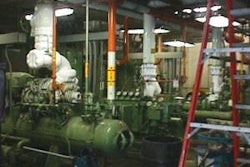
More bacterial reduction both in numbers and prevalence can be accomplished in a properly balanced chiller than anywhere else in the processing plant. Most studies demonstrate that the chiller can significantly reduce salmonella prevalence, if operating properly.
The chiller's pH, temperature, flow rate, flow direction, chlorine concentration and concentration of organic material (digesta, fat, blood) are crucial in order for the chlorine in the chiller to do its job. The pH should be 6.5 to 7.5, the temperature should be below 40 F, the flow rate should be high (at least one gallon per bird), and the flow direction should be counter-current. The most effective methods for controlling the pH of chill water include addition of carbon dioxide gas, citric acid or sodium acid sulfate to the water.
According to a U.S. Poultry and Egg Association survey, 90 percent of industry plants surveyed add carbon dioxide gas via the tubes normally used for air agitation. The remaining 10 percent of plants surveyed add either citric acid or sodium acid sulfate to the chiller water.
The organic material in the chiller is generally determined by the following factors:
Flow rate (amount of fresh make-up water)
Flow direction (should be counter-current)
Use of pre-scald bird brushes and cleanliness of the scalder
Temperature of the scalder
Number of high pressure carcass sprays used on the line prior to the chiller
Number of chill tanks (more tanks equals less organics).
Excessive organic material (blood, digesta, fat, protein) in the chiller will result in less chlorine being available to kill bacteria, as it will be bound up and rendered useless by the organic material.
Experiments conducted at the USDA's Western Regional Research Center, Agricultural Research Service, concluded that a free chlorine residual could not be established in a commercial poultry chiller even by adding up to 400 ppm of free chlorine. When chlorine reacts with organic material, it generally loses its microbiocidal properties, and can no longer act as a disinfectant. Therefore, efforts should be made to reduce the amount of organic material in these systems. Pre-scald bird brushes, effective carcass rinse systems, proper bleed-out procedures, counter-current scalders and chillers, proper fresh water make-up in scalders and chillers, all contribute to lowering organic loading of the chillers. Use of monochloramine can avoid these issues. Monochloramine is not bound by organic material, is effective, and does not result in the formation of carcinogenic compounds.
Many of the chillers in the industry are more like a bath than a river. The water is stagnant and organic material builds up during the shift. Also, fat builds up on the chiller paddles and sides of the chiller. This allows for salmonella to be encased in the fat, offering it protection from the sanitizers used in the chiller. Suggestions for maintaining a balanced chiller include the following:
Maintain proper water flow direction (counter-current).
Maintain proper water pH.
Maintain proper chlorine level.
Maintain water temperature below 40 F.
Chiller Setup
A properly operating chiller should have a visible gradient such that the water at the chiller exit is significantly cleaner than the water at the entrance. This is accomplished by adding all of the fresh water input and newly added chlorine directly to the exit end of the chiller as close to the exit paddles as possible. This will result in a "clean space" near the exit end of the chiller. In this space, chlorine will be able to act against bacteria, similar to the way a post-chill dip tank works.
Some companies in the poultry industry have set their chillers up incorrectly because of the new USDA-Food Safety Inspection Service requirement that companies must demonstrate that redwater being pumped back into chillers from the rechiller is "cleaner" or "has less bacteria and turbidity" than water coming out of the chillers in the overflow.
The regulation merely states that the water should be "cleaner." There are no real requirements listed to define what cleaner means. As a result, companies could reduce the bacteria by one colony-forming unit or turbidity by a very small amount and be in accordance with the ruling. The problem here is that by adding all of the chlorine that is to be added to the chiller into the redwater system, a major problem becomes evident. Companies generally add chlorine to the redwater system now and monitor the chiller overflow water for free available chlorine (FAC). As long as the FAC is low (a few ppm or below) then the amount going into the water may be increased. Sometimes the input of chlorine is excessive (100 to 150 ppm).
Monitoring FAC
The problem is that monitoring the FAC is not an appropriate way to determine chlorine levels. This is because, in the morning, when the organic load is low, the plant may need to add 40 ppm of chlorine to the redwater to achieve a 0.2 ppm FAC level. As the shift wears on and the water becomes loaded with organic material (fat, blood, protein), the amount of chlorine needed to be put into the redwater to achieve a 0.2 ppm FAC level may reach 150 ppm or higher. This is because the organic material binds to the chlorine and renders it ineffective for killing bacteria. Thus, the organic load is determining chlorine input. Also, all of the chlorine is being used up immediately by the organic material before it is able to contact the carcasses. Moreover, when the plant is reading 0.2 ppm FAC, it is likely that the kit is picking up organo-chlorine residuals that do not kill bacteria. There is no FAC in the chiller at all. The chlorine demand of an average poultry chiller is 400 ppm. Therefore, using FAC as a means of monitoring chlorine is inappropriate.
The problem with the chiller setup described above is that the chlorine is immediately deactivated upon addition to the redwater. Ideally, the chiller should be setup in such a way that the chlorine is added to the fresh make-up water and both should be added to the very exit end of the chiller. This setup allows the chickens to be exposed to very clean, chlorinated water. The chlorine has not been completely used up by the organic material in the redwater.
A survey in March of 2006 by the U.S. Poultry and Egg Association found the following chemicals used in the USA for chiller applications: hypochlorous acid (72 percent), peracetic acid (18 percent), chlorine dioxide (8 percent), bromine (1 percent) and monochloramine (1 percent). Other chemicals not listed in the survey that have been used in the industry include sodium acid sulfate and electrolyzed oxidative water. These chemicals all have advantages and disadvantages associated with their use and some companies may find that one or the other is most appropriate for their specific plant environment.
Overall, the chiller, if operated properly can be the most significant intervention step for controlling salmonella prevalence on broiler carcasses.




.jpg?auto=format%2Ccompress&fit=crop&h=167&q=70&w=250)












